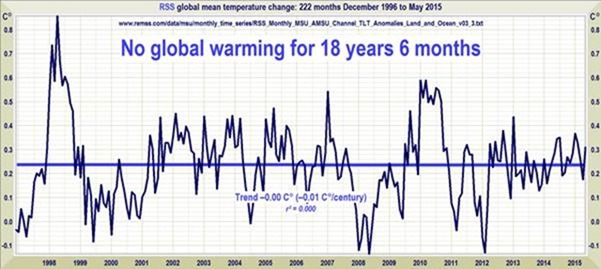Actually, the data is from NASA satellites processed by RSS. If you dispute the data you are free to refute it with whatever you feel is more convincing. Your opinion, for example.
Oh, you mean from those like at
Nature magazine, who said this in 2014:
Sixteen years into the mysterious ‘global-warming hiatus’, scientists are piecing together an explanation.
If you don’t believe your own scientists why are you surprised when others have little confidence them?
Ender
That statement is specific to one period of time and doesn’t mean that it isn’t on a warming trend. Read this from YOUR article. Wecan’t ignore the rest of the article now…

For several years, scientists wrote off the stall as noise in the climate system: the natural variations in the atmosphere, oceans and biosphere that drive warm or cool spells around the globe. But the pause has persisted, sparking a minor crisis of confidence in the field. Although there have been jumps and dips, average atmospheric temperatures have risen little since 1998, in seeming defiance of projections of climate models and the ever-increasing emissions of greenhouse gases.
Climate sceptics have seized on the temperature trends as evidence that global warming has ground to a halt. Climate scientists, meanwhile, know that heat must still be building up somewhere in the climate system, but they have struggled to explain where it is going, if not into the atmosphere. Some have begun to wonder whether there is something amiss in their models.
Now read the last two paragraphs. Nothing here about global warming not being a problem it just accounts for the variance in weather patterns.
There are two potential holes in his assessment. First, the historical ocean-temperature data are notoriously imprecise, leading many researchers to dispute Cane’s assertion that the equatorial Pacific shifted towards a more La Niña-like state during the past century10. Second, many researchers have found the opposite pattern in simulations with full climate models, which factor in the suite of atmospheric and oceanic interactions beyond the equatorial Pacific. These tend to reveal a trend towards more El Niño-like conditions as a result of global warming. The difference seems to lie, in part, in how warming influences evaporation in areas of the Pacific, according to Trenberth. He says the models suggest that global warming has a greater impact on temperatures in the relatively cool east, because the increase in evaporation adds water vapour to the atmosphere there and enhances atmospheric warming; this effect is weaker in the warmer western Pacific, where the air is already saturated with moisture.
Scientists may get to test their theories soon enough. At present, strong tropical trade winds are pushing ever more warm water westward towards Indonesia, fuelling storms such as November’s Typhoon Haiyan, and nudging up sea levels in the western Pacific; they are now roughly 20 centimetres higher than those in the eastern Pacific.** Sooner or later, the trend will inevitably reverse. “You can’t keep piling up warm water in the western Pacific,” Trenberth says. “At some point, the water will get so high that it just sloshes back.” And when that happens, if scientists are on the right track, the missing heat will reappear and temperatures will spike once again.**
You see how easily people can be misled into thinking that climate change isn’t happening when it in fact is? I’ve already shown that the Atlantic Ocean is warmer and warming up faster than the Pacific. Well that makes sense because of it’s size and depth and the gulf stream factors, etc. Now the concern about that is that the gulf stream will change it’s direction and affect Europe.
Shutdown of thermohaline circulation[edit]
Main article: Shutdown of thermohaline circulation
See also: Deglaciation
In 2005, British researchers noticed that the net flow of the northern Gulf Stream had decreased by about 30% since 1957. Coincidentally, scientists at Woods Hole had been measuring the freshening of the North Atlantic as Earth becomes warmer. Their findings suggested that precipitation increases in the high northern latitudes, and polar ice melts as a consequence. By flooding the northern seas with lots of extra fresh water,
global warming could, in theory, divert the Gulf Stream waters that usually flow northward, past the British Isles and Norway, and cause them to instead circulate toward the equator. If this were to happen, Europe’s climate would be seriously impacted.[19][20][21]
Downturn of AMOC (Atlantic meridional overturning circulation), has been tied to extreme regional sea level rise.[22]
en.wikipedia.org/wiki/Thermohaline_circulation
Note Nothing I’ve show up there says the scientists are saying global warming will level out and not be a problem in the future.

